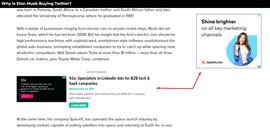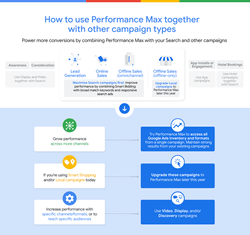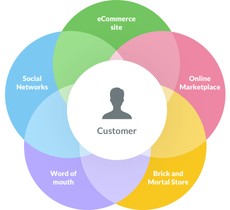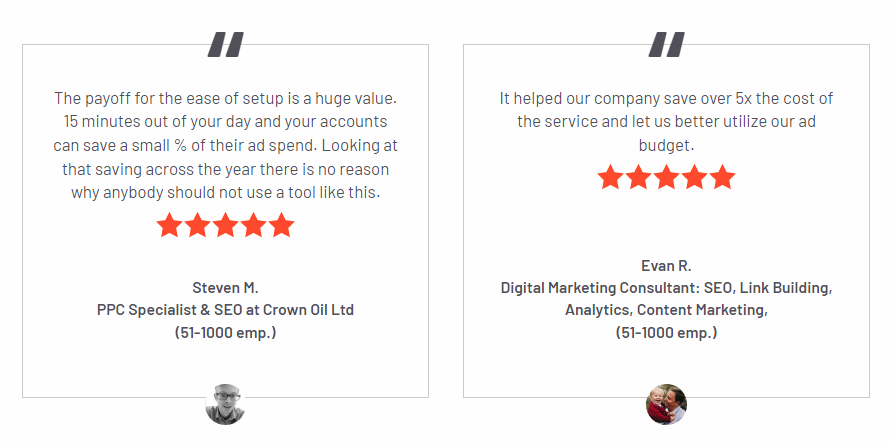We’ve pulled together a comprehensive list of top eCommerce marketing and advertising strategies to use in 2022 and beyond. Contained within this article are things you may already be doing, and plenty you may not. These tips will help you understand the world of online advertising better, whether you’re just getting started or you’re an old hat continuing your journey in the eCommerce industry.
#1 High-quality and Unique Content
The function of eCommerce content is to attract people to your website. So it should be optimized for SEO purposes and contain the information that your audience is looking for.
But do it in a natural and engaging way. Anyone that writes for a living will tell you it’s important to write for your audience first and Google second.
Writing high-quality content also involves researching what people are searching for and why they’re searching for it. Taking these things into account before you start will help you understand the mindset and intent of your audience.
Unique content doesn’t mean taking someone else’s article, rehashing it a bit and palming it off as your own. But it also doesn’t mean you have to offer a completely fresh take on something, especially if a subject has already been done to death. Present it in your own way, with your own style. Or hire a professional to help you.
#2 Retargeting Campaigns
97% of first-time visitors to your site will leave without buying anything.
If they visited, though, then there’s usually an intent to buy. Retargeting serves to remind them about your products/services while they’re still in the buying mindset. So when your ad pops up at a more convenient time, like when they’re at home with their feet up, it reminds them to revisit and reconsider buying.
There are lots of ways to do this – most social platforms with advertising as their main revenue stream like Facebook, Instagram and LinkedIn, will offer retargeting services. As do Google with Google Ads.
#3 Personalize Your Customers’ Experience
Isn’t it frustrating when you get an email that tries to sound all edgy and cool but auto-fills your first name as your surname, addresses you in reverse order (surname, first name) or even your business name, as happened to me recently with an email that started, “Dear Bottle Content.” Hmm.
Personalization is a big thing for consumers. People want to feel like you’re talking to them directly, rather than as one of a crowd. Even savvy customers who see through that appreciate the personal touch – who doesn’t?
Take the time to get to know your customers better. Understand how you can use their data to personalize their customer experience. This will help to build trust and increase their loyalty to you.
#4 Strong Social Presence
Having (or at least building) a good social media presence is essential. Period.
According to a report by Sprout Social:
As of January 2022, there are 3.96 billion total social media users across all platforms.
The average person bounces between seven different social networks per month.
The amount of time adults use social media across all platforms is now higher than ever — 95 minutes per day.
Social media platforms are great for engaging potential customers and generating higher website traffic. Posting good content regularly builds brand awareness and can catapult your business to new heights. So do some research to find out where your audience spends their time, and target those platforms.
#5 All Things SEO
So you’ve got a lovely website and you’re ready to sell. Now you need customers. Enter SEO.
In a nutshell, a solid SEO strategy will organize your website’s content and maximize your opportunity of showing up in search results.
Research is a big part of this. Knowing what your audience is searching for will help you understand what you need to focus your content on (tying back to #1).
Here’s a useful list of tips from Hubspot on how to do it:
- Make a list of topics
- Make a list of long-tail keywords based on these topics
- Build pages for each topic
- Set up a blog
- Create a consistent blogging schedule
- Create a link-building plan
- Compress media files before uploading them to your site
- Stay up-to-date on SEO news and best practices
- Measure and track your content’s success
#6 Affiliate Marketing (Influencers)
Influencer marketing has exploded in recent years and is without question one of the most powerful advertising methods.
Because of the power of social media, discussed in #4, it allows brands to target specific demographics by using an influencer that’s popular with your ideal customers.
This is down to the power of authenticity influencers exert upon their followers’ purchase decisions. Followers that prefer buying things recommended by their favorite influencer.
It’s not just about lifestyle products either – there are influencers in pretty much any niche you can think of. It’s helped lots of brands to grow so it’s unquestionably worth exploring.
#7 Google Smart Shopping (Soon Performance Max)
I wrote an article that goes into more detail on Google’s Performance Max campaigns.
To quote myself, “Performance Max is an effort by Google to…make it easier to advertise across their six main ad channels: Search, Maps, Display, Gmail, Discover, and YouTube.”
Wait, I haven’t finished yet. “It’s driven by automation and machine learning and works by taking the assets uploaded by the user, like headlines, images, and videos, then testing which combinations work best across each channel.”
What Google ultimately wants is for (me again), “users to be able to optimize each channel individually with the hope of increasing reach and conversions.”
There are some plus points, as well as the usual downsides to Google, especially around data visibility, but you’ll have to read my blog to make up your own mind on it.
#8 Shoppable Media
Let’s say you’ve teamed up with an influencer. Your engagement has skyrocketed. But your sales haven’t.
What’s the problem?
Maybe you’ve forgotten about shoppable media – essentially, a direct purchasing opportunity from whatever it is your customer is looking at.
Leaving customers to navigate their way through your site to find the item and buy it separately is asking for trouble. People cannot be bothered. Convenience is king.
So make sure you include a shoppable media strategy in your posts and make it easy for customers to buy.
This doesn’t just apply to socials, either – use it on landing pages, blogs and any other content where something is available to buy. Even on physical packaging!
#9 Cross-sell and Upsell
Cross-selling and upselling plugins are easy to implement and are a great way to increase customer spend (and satisfaction) across your website.
Unless you only sell one thing (skip this one if so) encourage your customers to consider related or complementary items. If they’re looking at a suit, for example, show them shirts, ties and shoes.
Or show them a comparable higher-end product than the one they’re looking at. That suit is nice, but for just $ amount extra, you can have this one. And so on.
#10 Omnichannel
An omnichannel strategy gives customers access to services and products across multiple platforms, devices and, as the name suggests, channels.
So instead of only offering, say, tech support on desktop, a customer can access it on their phone. Instead of only selling your wares on one platform, like Amazon, you sell it on Facebook and Etsy too. Instead of only using social media to advertise your stuff, you appear on Google search. You get the idea.
Ultimately, it means widening your reach and giving your customers more ways to find you, contact you and buy from you.
Bear in mind, too, that the experience for the customer should be the same across the board. Using the examples mentioned, your mobile customer service would be smooth and easy to use, not glitchy or clunky, annoying customers to the point of complaining or leaving altogether.
#11 Mobile Commerce
“The big problem retailers are facing is the world is moving to mobile.” – Dan Schulman, President of Paypal
Mobile devices account for 53% of all web traffic. According to eMarketer, the average US adult sounds 3 hours and 43 minutes on their phones. And people check their phones, on average, a massive 58 times a day.
So if you don’t have an app – consider one. Even if people don’t open web browsers each time they open their phone, they do check app notifications.
If your mobile site is not optimized – do it now. The last thing you want is a desktop page in a tiny font where customers have to enlarge the page to read it, never mind taking any sort of action.
Also think about ways you can incorporate everyday communication apps, like Facebook Messenger and WhatsApp, into your marketing and service.
#12 Optimize Product Listings
Spending budgets building and advertising landing pages is pointless if the listing of the product you’re selling isn’t optimized. There are lots to consider here but here are a few things to think about:
Firstly, make sure your products are priced correctly.
Depending on the product, the description should give enough info to help your customer, but not too much that overwhelms them.
Check your images. Are they clear across all devices, giving customers the option to zoom in or do a 360° of the whole product if they need to?
Imagine your product and its listing in a bricks-and-mortar store. Would it attract customers visiting with an intent to buy, and encourage a sale? Or would it be so uninspiring and confusing that you lose them?
Food for thought.
#13 Social Proof
Think about the last thing you bought. Something that you spent a bit of cash on, not a Mars bar at the petrol station. The last film you watched. The last battle of wine you ordered in a restaurant.
Did you text your mate, who you know just bought one, to ask what it was like?
Did you check IMDb or Rotten Tomatoes for film reviews?
Did you ask the server which wine they recommend?
These are all examples of social proof – the idea that people copy the actions of others in an attempt to emulate the behavior in certain situations.
Online, this means including things like testimonials from other users. Recommendations from other buyers. Reviews from industry experts or trusted sources, like TripAdvisor or Amazon.
This all adds weight to the perception of your product in the eyes of your customers, increasing the likelihood of a sale.
#14 Loyalty Programs
New customer acquisition ain’t cheap. But looking after your existing customer base costs a lot less. This is where loyalty programs add value to your business.
You can do this in several ways:
- Discounts
- Free samples
- Early access to sales
But frequent customers like to feel that their reward is relative to their loyalty. So keep an eye on them – measly rewards can backfire and make a customer feel undervalued.
#15 Delivery Offers
“Ooh that’s a very good price, think I’ll get that. Wait, what? Delivery is how much? Forget it.”
That was me not one week ago buying a $10 book on Amazon. Or, at least, attempting to.
Research by the Baymard Institute shows that nearly half of cart abandonments at checkout are down to extra costs, like shipping, taxes and other fees.
So offer discounts above a certain spend. Make it free, where you can. Even if that means swallowing a little of the cost yourself – you’ll soon make it up in sales.
#16 Optimize For Voice Search
In recent years, with the onset of Siri, Alexa and Google Assistant, voice search has been dominating the search sector.
The convenience of not having to interrupt chimichurri prep to ask how long a medium-rare step takes to grill trumps unlocking a phone with garlicky fingers for a quick Google search. At least, it does in my house.
According to eMarketer, at least 40% of all internet users in the US, and a third of its population, use voice search.
seoClarity found that 20% of all voice search queries are triggered by a set of just 25 keywords. Like ‘how’ and ‘what’. Or ‘best’ and ‘easy’.
And it’s expected to be a $40bn channel by the end of this year.
Best get cracking if you want a slice of that pie.
#17 Augmented and Virtual Reality
Recently, I needed some new glasses. So I browsed online and had a look at a well-known optician’s website. I chose a few I liked but the skeptic in me always doubts they’ll look the same in real life.
Then a pop-up appeared, encouraging me to “Try them on, with our AR technology.”
So I took a headshot, uploaded a few bits of data and before I knew it, there I was looking back at me with the glasses on. My head was viewable from every angle. And, after questioning the legitimacy of my side profile, I decided to buy them.
That is AR tech doing its thing.
If you’re a business that sells items that people wear, like clothes, makeup and glasses (of course) then it’s worth investing. People may be less likely to return things if they already have a good idea of what it looks like wearing them.
Aside from that, AR and VR are pretty cool and bound to enhance your customers’ online experience.
#18 Referral and Word-of-Mouth Marketing
Ok, I’ve held off for 17 tips but it’s time for a cliché: Word of mouth is the best type of marketing.
We touched on this a little on Social Proof in #13, but according to Nielsen, “92% of people trust recommendations from friends and family over any other type of advertising.”
Offer customers something in return for referring you to their social circles and relatives. This can be done in similar ways to the things we mentioned in #14 – coupons, discounts and other reward-based incentives.
#19 Case Studies
Case studies are a great example of social proof and are particularly effective in B2B marketing where more detail is needed to make a purchase decision.
This is the main benefit of a case study because customers want the full story – from how you were initially contacted to identifying the problem and how you went about solving it.
If you haven’t got any on your website, or your client doesn’t then consider hiring a copywriter to write some for you.
#20 Focus on Practical Data
With so much data available for analysis, it’s easy to feel overwhelmed. Which metrics to hit, which ones matter the most, and where improvements can be made.
Take a breath. Identify what you need and leave the rest for another time.
Brian Robben, from Robben Media, gives some good advice on this.
He says, “If data isn’t practical to act on, then it’s not worth my focus. As an SEO agency, we track seven main marketing campaign metrics for our clients – organic traffic, keyword rankings, backlinks, domain authority, traffic source, top pages, and the number of conversions. Every other data point is only going to be a distraction.”
#21 Stay Informed
We’ve already touched on Google phasing out Smart Shopping and introducing Performance Max.
We’re living through seismic changes to privacy regulations.
And TikTok has exploded.
These are just a few examples of the speed at which digital marketing evolves in the modern era.
So make sure you keep yourself up to date on advancing tech, changes to the regulatory landscape and what’s hot on social media.
#22 Track Social Analytics
With social media playing such a huge part in digital marketing campaigns, it’s important to see what’s working and what’s not.
You can do this in lots of ways, but David Morneau, of Influencer Marketing Agency, Inbeat, encourages businesses to firstly “define your conversions goal, for example, to increase conversions from social by 15% within three months.”
This will give you a clear objective and then something to measure results by.
Based on what you find, you can then “determine what content and engagement level are resulting in higher conversions and when.”
Lots of marketing is trial and error, and this is no different, but knowing what’s performing well allows you to maximize results in stronger areas and minimize waste in what’s not.
#23 Bounce Rate
One figure on your GA deck that can be equally as satisfying and panic-inducing is bounce rate.
“High bounce rates indicate a mismatch between your ranking keywords and the content of the page and can affect your SERP rankings,” says Sam Cohen, of Gold Tree Consulting.
Not good for lead generation and sales.
So what can you do?
“Go through the content of your pages and look at them from the user’s point of view. You may have keywords that drive a lot of traffic to your site but don’t generate conversions due to high bounce rates. Get rid of them or redesign your pages to make them more relevant to searches,” Sam suggests.
Make sure there’s a cohesive link between your keywords and what’s on your site. Otherwise, users get confused. And when users are confused, there’s no hiding place from the algorithm!
#24 Search Bar Data
This is an interesting one and not something you may have thought about doing before.
But implementing a search bar on your website not only helps users navigate the site, it can also give you data on what keywords they’re using.
And if you know what people are going to be searching for, you can produce more engaging content, driving improvement in keyword results and visitor numbers.
Smart little tip that, eh?
#25 Leverage a Multi-Touch Attribution Model
Google’s default setting is to use the last-click attribution model to track conversions.
But in reality, the journey to a purchase decision is longer and more informed than a solitary visit to a website would indicate.
Last-click attributions only credit the final channel the user came through.
This is dangerous because it might tempt you into putting all your eggs into that basket, and not giving enough attention to the other, erm…baskets… involved in the customer’s journey.
So be sure to check the ‘Top Conversions Path Report’ to get a more holistic view and enable a position-based on multi-touch attribution model across your ad campaigns.
#26 Make Use of Annotations
Don’t you sometimes wish you’d written something down, properly? Not just on the post-it that lost its stickiness, fell off and ended up attached to Sue from HR’s shoe?
This is where the annotations option with GA is particularly useful. It’s a tool that lets you add annotations (let’s call them notes like everyone else) to “any event that you think will be important to reference later on,” says Oleh Sorokopud of tech services provider, Softjourn.
They don’t have to be anything mind-blowing. They can mark the date you had a sale. The time you launched a new campaign. Or when you made any changes to your site.
Then, further down the line, you can pull up the data and compare how your changes impacted results.
Can’t beat a bit of pen and paper, can you? The principle of it, I mean.
#27 Track KPIs Regularly
Weekly, in fact. At an absolute push, monthly. How else can you see trends in what’s working and what’s not?
Okay, your current numbers tell you what’s happening here and now. But are they good? Have they improved since you did something new a few weeks or months ago? (Told you note-taking would come in handy). Or what?
Without tracking KPIs regularly over a period of time, you’ll never know.
Particular KPIs to keep an eye on are, according to Alving Garcia of ‘M is good’ :
- Impressions
- Clicks
- Cost
- CPC
- CTR
- Conversion events
- CPA
KPIs – Key Performance Indicators. Use them!
#28 Get Organized With Your Web Analytics
Login to your GA account. Is it organized, orderly and tidy? If not, spend some time cleaning it up.
We’ve talked a lot about the power of analytics within this article. But disorganized GA panels do not make for easy analytical work.
Imagine the scenario. You launched 10 new campaigns 6 months ago. But you didn’t name them properly. Your boss wants to talk about the results. And you don’t know which one is which. So now you have to dive into each one to see what it was about, wasting your own time keeping your boss waiting.
It’s one of those jobs that takes 5 seconds to do at the start. No excuses, make sure you do it properly. Good housekeeping benefits everyone.
Lecture over, you’re grounded for a week.
#29 Look Deeper With Analytics
We said earlier not to analyze every piece of data. It’s not necessary and it can easily overwhelm you. But that’s not to say you shouldn’t do a deeper dive from time to time when surface insights aren’t enough.
For example, your figures may show you a high bounce rate or exit percentage, but won’t tell you exactly why it’s happening. It could be down to a host of things, like the website running slowly or poor user experience.
This is the kind of thing that needs more scrutiny. The reasons behind a problem are there somewhere – dig patiently and you’ll find it.
#30 Check Your Acquisition Channels
We touched on this slightly in #25 but let’s expand on it a little further.
Understanding where your traffic is coming from enables you to spend time optimizing it.
If you know, for example, that Facebook users make up a large percentage of visitors, but Instagram is lagging behind, you know where you need to focus your efforts. That could be in refining Facebook even further, or making wholesale changes to your Instagram strategy.
Follow where users go on your site from each channel. See what they’re looking at or interested in buying. Then go back to your channel and incorporate it into your content.
As always, it’s about testing and refining to maximize results.
#31 Email Marketing
You’ve probably heard it said that email marketing is finished. Dated. That no-one reads emails anymore.
The reality is that 4.03bn people use email. And experts think that number will grow to 4.48bn by 2024.
That’s half the people alive today.
It’s more than Facebook (2.85bn) and Instagram (1bn) combined.
For ten years in a row, email is the channel generating the highest return on investment (ROI).
Research by The Data and Marketing Association has shown the ROI from email marketing to be a whopping $38 for every $1 spent. Nothing else tops it.
Analytics is mostly associated with socials and Google. Fair enough. But email analytics should not be overlooked.
So take the time to check how yours are doing. Things like spam rate, open rate and return on investment are all big indicators of how well your email marketing is doing, and whether it needs some work.
#32 Programmatic Bidding
The sun is shining. The weather is sweet, yeah. Makes me wanna move my dancing feet.
Apart from being a great song, this Bob Marley lyric highlights the impact weather can have on people.
Maybe it makes you want to dance, like Bob. Maybe you want to crack open a beer or a glass of wine. Or search Google for new sunglasses, flip-flops and that new BBQ you’ve had your eye on.
“My tip is to use a Google Ads script to programmatically fetch weather data and modify your bids to adjust if the condition is met,” says Lewis Kemp of Lightbulb Media.
“If there’s a freak heatwave outside, users are much more likely to be searching for shorts and t-shirts rather than wooly jumpers and bobble hats. By using this data and marketing automation to your advantage, you’ll be able to profit from any weather scenario.
#33 Improve Your Website Loading Time
47% of Internet users expect a page to load within two seconds. A further 40% will wait one more before leaving.
That’s all you’ve got to make sure your page is fully loaded and showing your wares.
Your GA dashboard helps you identify slow-loading pages and take action to fix them.
Meet the two-second threshold, and you’re quids in.
#34 Analyze best-performing pages
On the flip side, be sure to check which of your pages are drawing in the most traffic and conversions.
This ties in with #1 around providing unique content. Knowing which of your pages and blog posts convert visitors to customers will give you a good idea of where to focus your content.
In turn, the better the content, the more attention it grabs from Google, the more visitors hit your site and the more conversions you get.
The opposite of a vicious cycle.
#35 Remove Invalid Data
Finally, the one you’ve been waiting for. No list of marketing strategies would be complete without talking about the very things we help you to avoid.
Not having a solid invalid data strategy in place wastes precious budget, skews invaluable data and wreaks havoc with marketing campaigns.
Multiple site visits from bots and spammers trawling the site can trick you into thinking content is performing better than it is. And, as we mentioned in #34, analysing what is doing well forms the basis for future content planning.
Inaccurate data = inaccurate insights = inaccurate future strategy = worse results.
But it’s not just bots and spammers that can skew the data. Be sure to filter out internal traffic too. Using clean data will give you the best chance at optimizing your website, creating campaigns and implementing marketing strategies.
Automatically remove all invalid user data from your marketing campaigns with a free trial on us – No obligation to purchase. 4 minutes is all it takes.













